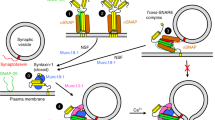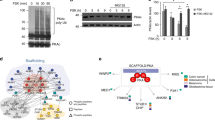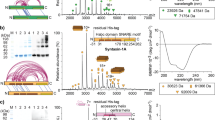Abstract
cAMP-dependent protein kinase A (PKA) can modulate synaptic transmission by acting directly on unknown targets in the neurotransmitter secretory machinery. Here we identify Snapin, a protein of relative molecular mass 15,000 that is implicated in neurotransmission by binding to SNAP-25, as a possible target. Deletion mutation and site-directed mutagenetic experiments pinpoint the phosphorylation site to serine 50. PKA-phosphorylation of Snapin significantly increases its binding to synaptosomal-associated protein-25 (SNAP-25). Mutation of Snapin serine 50 to aspartic acid (S50D) mimics this effect of PKA phosphorylation and enhances the association of synaptotagmin with the soluble N-ethylmaleimide-sensitive factor attachment protein receptor (SNARE) complex. Furthermore, treatment of rat hippocampal slices with nonhydrolysable cAMP analogue induces in vivo phosphorylation of Snapin and enhances the interaction of both Snapin and synaptotagmin with the SNARE complex. In adrenal chromaffin cells, overexpression of the Snapin S50D mutant leads to an increase in the number of release-competent vesicles. Our results indicate that Snapin may be a PKA target for modulating transmitter release through the cAMP-dependent signal-transduction pathway.
This is a preview of subscription content, access via your institution
Access options
Subscribe to this journal
Receive 12 print issues and online access
$209.00 per year
only $17.42 per issue
Buy this article
- Purchase on Springer Link
- Instant access to full article PDF
Prices may be subject to local taxes which are calculated during checkout







Similar content being viewed by others
References
Rothman, J. E. Mechanisms of intracellular protein transport. Nature 372, 55–63 (1994).
Bajjalieh, S. M. & Scheller, R. H. The biochemistry of neurotransmitter secretion. J. Biol. Chem. 270, 1971–1974 (1995).
Südhof, T. C. The synaptic vesicle cycle: a cascade of protein-protein interactions. Nature 375, 645–653 (1995).
Hilfiker, S., Greengard, P. & Augustine, G. J. Coupling calcium to SNARE-mediated synaptic vesicle fusion. Nature Neuroscience 2, 104–106 (1999).
Trimble, W. S., Cowan, D. M. & Scheller, R. H. VAMP-1: a synaptic vesicle-associated integral membrane protein. Proc. Natl Acad. Sci. USA 85, 4538–4542 (1988).
Bennett, M. K., Calakos, N. & Scheller, R. H. Syntaxin: a synaptic protein implicated in docking of synaptic vesicles at presynaptic active zones. Science 257, 255–259 (1992).
Oyler, G. A. et al. The identification of a novel synaptosomal-associated protein, SNAP-25, differentially expressed by neuronal subpopulations. J. Cell. Biol. 109, 3039–3052 (1989).
Söllner, T. et al. SNAP receptors implicated in vesicle targeting and fusion. Nature 362, 318–324 (1993).
Calakos, N., Bennett, M. K., Peterson, K. & Scheller, R. H. Protein-protein interactions contributing to the specificity of intracellular vesicular trafficking. Science 263, 1146–1149 (1994).
Hayashi, T. et al. Synaptic vesicle membrane fusion complex: action of clostridial neurotoxins on assembly. EMBO J. 13, 5051–5061 (1994).
Weber, T. et al. SNAREpins: minimal machinery for membrane fusion. Cell 92, 759–772 (1998).
Chen, Y. A., Scales, A. J., Patel, S. M., Doung, Y.-C. & Scheller, R. H. SNARE complex formation is triggered by Ca2+ and drives membrane fusion. Cell 97, 165–174 (1999).
Bommert, K. et al. Inhibition of neurotransmitter release by C2-domain peptides implicates synaptotagmin in exocytosis. Nature 363, 163–165 (1993).
Broadie, K., Bellen, H. J., DiAntonio, A., Littleton, J. T. & Schwarz, T. L. Absence of synaptotagmin disrupts excitation–secretion coupling during synaptic transmission. Proc. Natl Acad. Sci. USA 91, 10727–10731 (1994).
Geppert, M. et al. Synaptotagmin I: a major Ca2+ sensor for transmitter release at a central synapse. Cell 79, 717–727 (1994).
Bliss, T. V. P. & Collingridge, G. L. A synaptic model of memory: long-term potentiation in the hippocampus. Nature 361, 31–39 (1993).
Nicoll, R. A. & Malenka, R. C. Contrasting properties of two forms of long-term potentiation in the hippocampus. Nature 377, 115–118 (1995).
Martinez, J. L. Jr, & Derrick, B. E. Long-term potentiation and learning. Annu. Rev. Psychol. 47, 173–203 (1996).
Bouron, A. & Reuter, H. Muscarinic stimulation of synaptic activity by protein kinase C is inhibited by adenosine in cultured hippocampal neurons. Proc. Natl Acad. Sci. USA 94, 12224–12229 (1997).
Dixon, D. & Atwood, H. L. Adenylated cyclase system is essential for long-term facilitation at the crayfish neuromuscular junction. J. Neurosci. 9, 4245–4252 (1989).
Chavez-Noriega, L. E. & Stevens, C. F. Increased transmitter release at excitatory synapses produced by direct activation of adenylated cyclase in rat hippocampal slices. J. Neurosci. 14, 310–317 (1994).
Klein, M. Synaptic augmentation by 5-HT at rested Aplysia sensorimoter synapses: independence of action potential prolongation. Neuron 13, 159–166 (1994).
Capogna, M., Gähwiler, B. H. & Thompson, S. M. Presynaptic enhancement of inhibitory synaptic transmission by protein kinases A and C in the rat hippocampus in vitro. J. Neurosci. 15, 1249–1260 (1995).
Chavis, P., Mollard, P., Bockaert, J. & Manzoni, O. Visualization of cyclic AMP-regulated presynaptic activity at cerebellar granule cells. Neuron 20, 773–781 (1998).
Huang, Y. Y., Li, X. C. & Kandel, E. R. cAMP contributes to mossy fiber LTP by inititating both a covalently mediated early phase and a macromolecular synthesis-dependent late phase. Cell 79, 69–79 (1994).
Weisskopf, M. G., Castillo, P. E., Zalutsky, R. A. & Nicoll, R. A. Mediation of hippocampal mossy fiber long-term potentiation by cyclic-AMP. Science 265, 1876–1882 (1994).
Trudeau, L. E., Emery, D. G. & Haydon, P. G. Direct modulation of the secretory machinery underlies PKA-dependent synaptic facilitation in hippocampal neurons. Neuron 17, 789–797 (1996).
Trudeau, L. E., Fang, Y., & Haydon, P. G. Modulation of an early step in the secretory machinery in hippocampal nerve terminals. Proc. Natl Acad. Sci. USA 95, 7163–7168 (1998).
Ilardi, J. M., Mochida, S., & Sheng, Z.-H. Snapin: a SNARE-associated protein implicated in synaptic transmission. Nature Neurosci. 2, 119–124 (1999).
Kennelly, P. J. & Krebs, E. G. Consensus sequences as substrate specificity determinants for protein kinases and protein phosphatases. J. Biol. Chem. 266, 15555–15558 (1991).
Risinger, C. & Bennett, M. K. Differential phosphorylation of syntaxin and synaptosome-associated protein of 25 kDa (SNAP-25) isoforms. J. Neurochem. 72, 614–624 (1999).
Hirling, H. & Scheller, R. H. Phosphorylation of synaptic vesicle proteins: modulation of the αSNAP interaction with the core complex. Proc. Natl Acad. Sci. USA 93, 11945–11949 (1996).
Foster, L. J. et al. Binary interactions of the SNARE proteins syntaxin-4, SNAP23, and VAMP-2 and their regulation by phosphorylation. Biochem. 37, 11089–11096 (1998).
Sandberg, M. et al. Characterization of Sp-5,6-dichloro-1-β-D ribofuranosylbenzimidazole-3′,5′-monophosphorothioate (Sp-5,6-DCl-cBIMPS) as a potent and specific activator of cyclic AMP-dependent protein kinase in cell extracts and intact cells. Biochem. J. 279, 521–527 (1991).
Neher, E. Vesicle pools and Ca2+ microdomains: new tools for understanding their roles in neurotransmitter release. Neuron 20, 389–399 (1998).
Ashery, U. et al. Munc13-1 acts as a priming factor for large-dense core vesicles in bovine chromaffin cells. EMBO J. 19, 3586–3596 (2000).
Brose, N., Rosenmund, C. & Rettig, J. Regulation of transmitter release by Unc-13 and its homologues. Curr. Opin. Neurobiol. 10, 303–311 (2000).
Fykse, E. M., Li, C. & Südhof, T. C. Phosphorylation of rabphilin-3A by Ca2+/calmodulin- and cAMP-dependent protein kinases in vitro. J. Neurosci. 15, 2385–2395 (1995).
Lonart, G. & Südhof, T. C. Region-specific phosphorylation of rabphilin in mossy fiber nerve terminals of the hippocampus. J. Neurosci. 18, 634–640 (1998).
Castillo, P. E. et al. The synaptic vesicle protein rab3A is essential for mossy fiber long term potentiation in the hippocampus. Nature 388, 590–593 (1997).
Geppert, M. et al. Rab3A functions in neurotransmitter release. Nature 369, 493–497 (1994).
Li, C. et al. Synaptic targeting of rabphilin-3A, a synaptic vesicle Ca2+/phospholipid-binding protein, depends on rab3A/3C. Neuron 13, 885–898 (1994).
Lonart, G., Janz, R., Johnson, K. M. & Südhof, T. C. Mechanism of action of rab3A in mossy fiber LTP. Neuron 21, 1141–1150 (1998).
Yokoyama, C. T., Sheng, Z-H., & Catterall, W. A. Phosphorylation of the synaptic protein interaction site on N-type calcium channels inhibits interactions with SNARE proteins. J. Neurosci. 17, 6929–6938 (1997).
Sheng, Z-H., Rettig, J., Cook, T. & Catterall, W. A. Calcium-dependent interaction of N-type calcium channels with the synaptic core complex. Nature 379, 451–454 (1996).
Dunkley, P. R. et al. A rapid percoll gradient procedure for isolation of synaptosomes directly from an S1 fraction: homogeneity and morphology of subcellular fractions. Brain Res. 441, 59–71 (1988).
Yan, Z., Feng, J., Fienberg, A. A. & Greengard, P. D2 dopamine receptors induce mitogen-activated protein kinase and cAMP response element-binding protein phosphorylation in neurons. Proc. Natl Acad. Sci. USA 96, 11607–11612 (1999).
Diamond, J. S., Bergles, D. E. & Jahr, C. E. Glutamate release monitored with astrocyte transporter currents during LTP. Neuron 21, 425–433 (1998).
Ashery, U., Betz, A., Xu, T., Brose, N. & Rettig, J. An efficient method for infection of adrenal chromaffin cells using the Semliki Forest virus gene expression system. Eur. J. Cell Biol. 78, 525–532 (1999).
Acknowledgements
We thank Q. Su for constructs of pSFV1-Snapin mutants, C. M. Gerwin, A. Bührmann and F. Friedlein for technical assistance, X. Zheng for synaptsome preparations, J. S. Diamond for hippocampal slices, M. Takahashi for antibodies, and J. W. Nagle for DNA sequencing. We also thank H. Gainer, C. T. Yokoyama, S. Das and J. Coulombe for comments on the manuscript, and E. Neher for continuous support. This work was supported by the intramural research program of NINDS, NIH (to Z-H. S.), the Deutsche Forschungsgemeinschaft (to J.R.), an EU Network Grant (to U.A.), and the HHMI-NIH Research Scholars Program (to M.G.C.).
Author information
Authors and Affiliations
Corresponding author
Rights and permissions
About this article
Cite this article
Chheda, M., Ashery, U., Thakur, P. et al. Phosphorylation of Snapin by PKA modulates its interaction with the SNARE complex. Nat Cell Biol 3, 331–338 (2001). https://doi.org/10.1038/35070000
Received:
Revised:
Accepted:
Published:
Issue Date:
DOI: https://doi.org/10.1038/35070000
This article is cited by
-
Synaptic retrograde regulation of the PKA-induced SNAP-25 and Synapsin-1 phosphorylation
Cellular & Molecular Biology Letters (2023)
-
Changes in cognitive function, synaptic structure and protein expression after long-term exposure to 2.856 and 9.375 GHz microwaves
Cell Communication and Signaling (2023)
-
DYRK3 phosphorylates SNAPIN to regulate axonal retrograde transport and neurotransmitter release
Cell Death Discovery (2022)
-
Structural and Functional Characterization of the Interaction of Snapin with the Dopamine Transporter: Differential Modulation of Psychostimulant Actions
Neuropsychopharmacology (2018)
-
Zinc finger protein ZPR9 functions as an activator of AMPK-related serine/threonine kinase MPK38/MELK involved in ASK1/TGF-β/p53 signaling pathways
Scientific Reports (2017)



